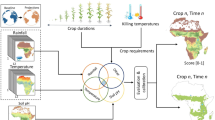Abstract
Climate change is the main global challenge of this century; it is therefore imperative to identify its effects on agriculture in developing countries. This research makes spatial assessment of climate change effect on major plantation crops in Sri Lanka, with emphasis on crop suitability of tea, rubber, and coconut. Geo-referenced maps of spatial and temporal changes in crop suitability and production potentials are generated and compared. Data pertaining to six agro-ecological zones under the study area are analyzed for a period of 1980–2007. Crop suitability maps are generated amalgamating yield maps and climatic factors maps using AHP in multi-criteria analysis under two time frames of 1980–1992 and 1993–2007. Percent change in crop suitability and crop yield classes is calculated based on five crop suitability and five crop yield classes during two time frames. Dynamics of climatic parameters and crop yield are recognized using geo-referenced maps. The suitability maps of the two time frames are compared to identify the changes with each crop in conjunction with changes in the prevailing climate and yield. Geographic shift of suitability, yield, and climate classes are examined. Net gain or loss in crop production is quantified. Long-term annual rainfall significantly decreased in mid-country wet zone, whereas the mean temperature of the study area increased by 1.4°C. Results clearly showed that the climate and yield can be meaningfully related to the crop suitability and management.





Similar content being viewed by others
References
Abeywardena V (1971) Crop losses in coconut through button shedding and immature nut fall. Ceylon Coconut Planters Rev 6:97–105
Anandacoomaraswamy A, De Costa WAJM, Shyamalie HW, Campbell GS (2000) Factors controlling transpiration of mature field grown tea and its relationship with yield. Agric For Meteorol 103:375–386
Bandara CMM, Wickramagamage P (2004) Climate change and its impact on upper watershed of the hill country of Sri Lanka. Climate change secretariat working paper. Environmental economics and global affairs division, Ministry of environment and natural resources, Battaramulla, Sri Lanka
Basnayaka BRSB, Vithnage JC (2004) Rainfall change scenarios for Sri Lanka under the anticipated climate change. National Water Resources Secretariat, Sri Lanka
Benjamin LP, Ramasamy S, Ian M, Janice B (2006) Climate change in the Asia/Pacific region. Climate change impacts and risk. CSIRO Marine and Atmospheric Research, Australia
Central Bank of Sri Lanka (2010) Annual Report, Colombo vol 60: No. 10. Retrieved on 15 April 2010. http://www.cbsl.gov.lk/
Fernando MTN, Zubair L, Peiris TSG, Ranasinghe CS, Ratnasiri J (2007) Economic value of climate variability impacts on coconut production in Sri Lanka. AIACC working paper no.45. March 2007
Goyal RK (2004) Sensitivity of evapotranspiration to global warming, a case study of arid zone of Rajasthan (India). Division of Natural Resources and Environment, Central Arid Zone Research Institute, Rajasthan, India
Herath S, Ratnayake U (2004) Monitoring rainfall trends to predict adverse impacts—a case study from Sri Lanka (1964–1993). Glob Environ Chang 14:71–79
Hopkins D (1977) Method of generating land suitability maps, a comparative evaluation. Am Inst Plann 43(4):386–400
Jayakody JAAM, Ariyapala ASB, Roy J (2004) Economic impact of climate change on productivity growth of tea. The experiments and extension forum report. Sri Lanka, Tea Research Institute of Sri Lanka
Johnston RM, Kevin SJ, Ver Hoel E, Jay M, Krivoruchko EN, Konstantin CJ, Lucas DA, Neil P (2001) Using ArcGIS geostatistical analyst. Environmental Systems Research Institute (ESRI), Califonia
Miah AQ (1993) A course handbook for human settlement planning. Division of human settlement development, Asian Institute of Technology, Thailand
Ministry of Plantation Industries (2008) Statistical pocket book plantation sector, Sri Lanka, Colombo
Peiris TSG, Thattil RO (1998) The study of climate effects on the nut yield of coconut using parsimonious models. J Exp Agric 34:189–206
Peiris TSG, Thattil RO, Mahindapala R (1995) An analysis of the effect of climate and weather on coconut (Cocos nucifera). Exp Agric 31:451–460
Peiris TSG, Peiris TSU, Rajapksha S (2000) Prediction of annual national coconut production–a stochastic approach. J Appl Stat Sri Lanka 1:25–32
Pratummintra S, Kesawapitak P (2001) The monthly production potential in the eastern provinces of Thailand by using the rubber production potential models and geo-informatics. Rubber Research Institute, Department of Agriculture, Bangkok
Rao PS, Jayarathnam K, Senhuraj MR (1993) An index to assess areas hydro thermally suitable for rubber cultivation. Indian J Nat Rubber Res 6:80–91
Rao PS, Saraswathyamma CK, Sethuraj MR (1997) Studies on the relationship between yield and meteorological parameters of para rubber tree (Hevea brasiliensis). Agric For Meteorol 90:235–245
Samarappuli L, Wijesuriya Wasana (2006) A prospective plantation crop to combat adverse impacts of climate change. The journal of the Rubber Research Institute, Sri Lanka
Satty TL (1980) The analytic hierarchy process. Mcgraw-Hill, New York
Satty TL, Kearns KP (1985) Analytical planning, the organization of systems. Oxford, Pergamon
Somasiri LLW, Nadarajah N, Amarasinghe L, Gunatilake HAJ (1994) Land suitability assessment of coconut growing areas in the coconut triangle. Coconut Research Institute of Sri Lanka, Lunuwila (Colombo)
Watson M (1986) Soil and climatic requirements. In: Sivapalan P, Kulasegaram S, Kathiravetpillai A (eds) Handbook on tea. Tea Research Institute, Sri Lanka, pp 3–5
Wijeratne MA (2004) Impact of climate change on productivity of tea plantations in Sri Lanka. The experiments and extension forum report. TRI, Sri Lanka
Wijeratne MA, Anandacoomaraswamy A, Amaratunga MKSLD, Janaka Ratnasiri, Basnayaka BRSB, Kalra N (2007) Assessment of impact of climate change on productivity of tea plantations in Sri Lanka. Natural science foundation Sri Lanka
Yamane T (1967) Statistics, An Introductory Analysis, 2nd edn. Harper and Row, New York
Author information
Authors and Affiliations
Corresponding author
Rights and permissions
About this article
Cite this article
Jayathilaka, P.M.S., Soni, P., Perret, S.R. et al. Spatial assessment of climate change effects on crop suitability for major plantation crops in Sri Lanka. Reg Environ Change 12, 55–68 (2012). https://doi.org/10.1007/s10113-011-0235-8
Received:
Accepted:
Published:
Issue Date:
DOI: https://doi.org/10.1007/s10113-011-0235-8




